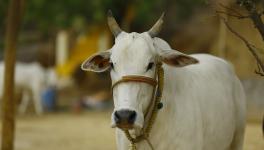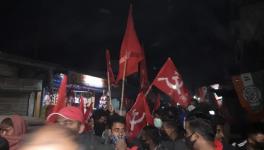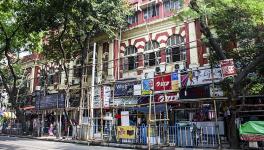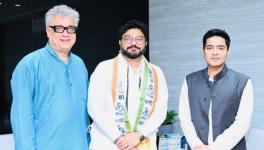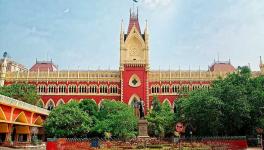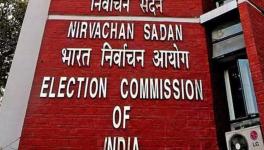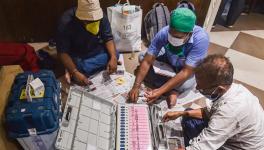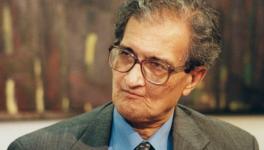Power Tussle Brews in BJP’s Bengal Unit After Tathagata Roy’s Return
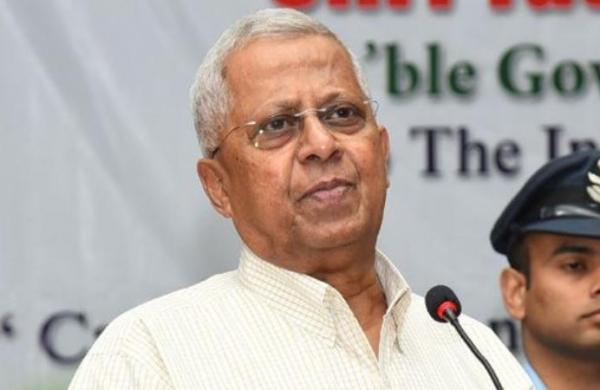
BJP leader Tathagata Roy . Image Courtesy: PTI
Kolkata: In what appears to be the first sign of a power tussle within the West Bengal unit of the Bharatiya Janata Party (BJP), Tathagata Roy, the former Governor of Meghalaya, announced resumption of an active role in state politics. Roy made the announcement soon after his return to Kolkata from Shillong on August 23.
The return of Roy, a former BJP state unit president, known for making controversial statements even while holding a constitutional post as Governor, to active innings again in state politics, is being seen by his party activists and even other political quarters, as a reflection of his desire to be projected as the BJP’s “CM face” for West Bengal Assembly elections due eight months.
Perhaps, corroborating this is the sudden appearance of a Facebook page ‘Tathagata Roy for CM’, though Roy has denied any knowledge about the people behind this page.
Amid all this, the central BJP leadership swung into action and put all speculation to rest. On August 24, Kailash Vijayvargiya, party general secretary and in-charge for West Bengal, announced that BJP would fight the next Assembly elections “without a CM face”, in keeping with its policy of not projecting any one as a chief minister candidate where the party is not in power.
From what BJP’s co-incharge for West Bengal, Arvind Menon, told NewsClick, it seems the party top brass does not want any distraction on the issue of a chief ministerial face. Menon, who hails from Kerala and speaks Bengali fluently, said: “We are currently focused on addressing our deficiencies, taking the membership drive forward and organising booth-level committees. Now, we have close to one crore members. Our target is 3.5 crore members.”
Menon, who is considered close to Rashtriya Swayamsevak Sangh’s chief Mohan Bhagwat, added: “We have to popularise two slogans : first, ‘My family is BJP family’ and second, ‘Chup chap Kamal phule chhap” (Quietly put a stamp on Lotus flower – BJP’s election symbol).
Interestingly, the second slogan is an offshoot of Trinmool Congress (TMC) leader, Mamata Banerjee’s slogan in 2011: “Chup chap ghashfule chhap” – (Quietly stamp on the grass and flower -- TMC’s poll symbol).
The BJP says it is trying to quietly address what it terms as “one of the deficiencies” in West Bengal -- the “total absence in terms of identification with Bengal’s culture, ethos and icons, like Syama Prasad Mookerjee,” the founder of Jan Sangh, the original ‘avatar’ of BJP.
An attempt has been made by the BJP to invoke Syama Prasad Mookerjee, an example of which is the Narendra Modi government’s rechristening of Kolkata Port Trust as Syama Prasad Mookerjee Port Trust.
But, Mookerjee won’t be a paying proposition electorally for the BJP for various reasons, according to an assessment by people in the know of things, who believe the BJP central leadership is also aware of this reading.
Karnataka and Assam notwithstanding, BJP is still reckoned as a Hindi heartland political force. Given the limitation of this identity, in West Bengal it is trying to go beyond its usual pantheon, such as Syama Prasad, Deendayal Upadhyayay and Veer Savarkar.
Thus, BJP was seen observing ‘Baisey Sravan’ (22nd day of Sravan /August 7), the death anniversary of Nobel laureate Rabindra Nath Tagore. Party president JP Nadda also recorded a video message of BJP’s determination to rid West Bengal of “misgovernance”. On August 4, state BJP president Dilip Ghosh paid tributes to Birendra Krishna Bhadra, well-known for the legendary rendition of Mahalaya, on his birth anniversary.
The party is keen on making the Assembly election as a TMC versus BJP, which possibly explains why no BJP leader is heard mentioning the Left Front-Congress platform. Against TMC and Mamata Banerjee, BJP’s strategy so far appears to be to highlight “corruption” in administration and “misgovernance”. The Saradha chit fund and the Narada sting operation-cum-bribery cases are very much there, perhaps waiting to be activated “at the right time”.
Given Banerjee’s hold over 28-30% Muslim vote in the state, the BJP may also try to cause a split in this vote bank. Asaduddin Owaisi of the All India Majlis-e-Ittehad-ul-Muslimeen or AIMIM, has already announced his intention to field some candidates.
And, of course, BJP will play the Citizenship Amendment Act card to win over the Matua voters, who matter in several districts and in about 85-90 Assembly segments out of the 294 seats. In the 2011 Assembly elections and 2014 Lok Sabha elections, Mamata Banerjee had received solid support of the Matuas. But, thereafter, BJP succeeded in making inroads into this vote bank.
The Matua is a sect of Vaishnavite Hinduism. Theirs was a religious reform movement which originated in what is today Bangladesh. It was a dalit movement led by the Namashudra community. After Partition, a large number of them migrated to West Bengal in India.
In the context of the unfolding components of BJP’s poll politics in West Bengal, NewsClick sought the assessment of two senior persons from the academic world.
Sobhanlal Datta Gupta, former Surendra Nath Banerjee Professor of Political Science, University of Calcutta, is of the view that the electronic media substantially and the mainstream print media to a fair extent are responsible for creating an impression, after BJP won 18 Lok Sabha seats in 2019, that the party had emerged as the alternative to TMC and that other political forces had virtually lost their relevance in West Bengal politics.
He points out that in the lockdown phase and post-Amphan (cyclonic storm), the Left parties have been doing considerable work among the affected and the distressed, but the media is not taking any cognisance of their good work.
Datta Gupta also notes that bickering within the BJP has accentuated after Tathagata Roy’s plunge for a fresh innings. The inner strife within BJP is largely attributable to uneasy relations between two top party leaders -- Dilip Ghosh and Mukul Roy. Roy, who was earlier quite influential in TMC, continues to wait for a meaningful role in the BJP. Moreover, the average Bengali considers BJP as a North Indian party with no connect with Bengali culture and heritage, he observes.
But, there are some signs of a tilt toward BJP among Bengali Hindu middle class which, Datta Gupta, thinks is “because of the Modi factor at the national level. Very cleverly they are being repeatedly reminded of their Hindu identity. I get this impression when I happen to talk to my friends, relatives and acquaintances among the Hindu Bengali middle class.”
According to Surajit C Mukhopadhyay, who teaches sociology at Amity University at Raipur in Chhattisgarh, being basically a Hindi heartland organisation, BJP’s ethos and political programme overlap and it is easy to appropriate.
“But, Bengal has a syncretic culture, which is quite different from the Hindi heartland culture. BJP, therefore, has to negotiate Bengal’s syncretic culture. Mamata identifies herself with Rabindra Sangeet, folk songs and other cultural aspects very closely. Buddhadeb Bhattacharya (former Left Front chief minister) too was culturally-oriented, he himself authored a play”, Mukhopadhyay says.
When asked whether voters would remember the BJP’s good performance in the 2019 Lok Sabha elections, Mukhopadhyay told NewsClick: “Our voters are quite smart; they can differentiate among general elections, state elections and local body/panchayat elections. What they did in the last Lok Sabha polls can, perhaps, be explained as their exercising an option, which they did not see earlier but which they saw in 2019”.
As for a chief minister, should an opportunity come their way, BJP will have to evolve a consensus, he observed. It may be mentioned that Tathagata Roy’s emergence on the scene has added a new dimension to BJP’s politics in the state because Dilip Ghosh (state party president), earlier an RSS ‘pracharak’ and close to the Sangh leadership in Nagpur, is known to consider himself “an automatic choice” for CM.
Get the latest reports & analysis with people's perspective on Protests, movements & deep analytical videos, discussions of the current affairs in your Telegram app. Subscribe to NewsClick's Telegram channel & get Real-Time updates on stories, as they get published on our website.









